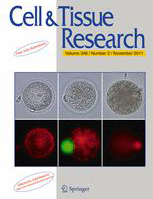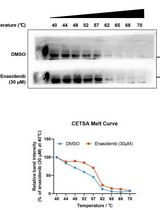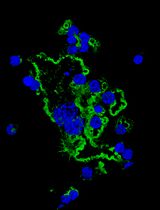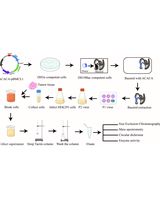- EN - English
- CN - 中文
3D Stroma Invasion Assay
三维基质侵袭实验
发布: 2017年03月20日第7卷第6期 DOI: 10.21769/BioProtoc.2195 浏览次数: 9270
评审: HongLok LungAnonymous reviewer(s)
Abstract
We have developed a 3D co-culture system composed of fibroblasts and colorectal cancer cells that enables us to study the desmoplastic reaction. This method also enables us to study the influence of the desmoplastic reaction on the migration of colorectal cancer cells through the surrounding stroma. This protocol has been previously published (Coulson-Thomas et al., 2011) and is described here in more detail.
Keywords: 3D culture (三维培养)Background
The progression of cancer relies on intricate cross-talk between the cancer cells and surrounding cells, such as fibroblasts, inflammatory cells and endothelial cells, which form the cancer microenvironment. Fibroblasts are the major extracellular matrix producing cells and are responsible for the structural formation of tissues. Fibroblasts surrounding tumors are ‘activated’ by cancer cells into tumor-associated fibroblasts (TAFs) and play key roles in tumorigenesis and metastasis. In some cancers, TAFs up-regulate extracellular matrix expression producing an unorganized matrix, consisting mainly of collagen fibers and proteoglycans, which affects cancer cell proliferation, migration and spread. This is called the desmoplastic reaction, and during cancer cell growth different tumors may exhibit various grades of desmoplasia.
Materials and Reagents
- NuncTM Lab-TekTM II Chamber SlideTM System with 2 wells (Thermo Fisher Scientific, Thermo ScientificTM, catalog number: 154461 )
- NuncTM cell culture dishes (Thermo Fisher Scientific, Thermo ScientificTM, catalog number: 172931 )
- Cotton swabs
- Human colorectal fibroblasts CCD-112CoN (ATCC, catalog number: CRL-1541 )
- Caco-2 and HCT 166 cancer cell lines isolated from primary colorectal tumors (ATCC, catalog numbers: HTB-37 and CCL-247 )
- pEGFP-N1 (TaKaRa Bio, Clontech)
- DMEM culture medium (Thermo Fisher Scientific, GibcoTM)
- RPMI culture medium (Thermo Fisher Scientific, GibcoTM)
- Fetal bovine serum (FBS) (Thermo Fisher Scientific, GibcoTM)
- L-glutamine (Thermo Fisher Scientific, GibcoTM, catalog number: 25-030-081 )
- Penicillin/streptomycin (Thermo Fisher Scientific, InvitrogenTM)
- L-ascorbic acid (Sigma-Aldrich, catalog number: A4403 )
- Collagen I
- Anti-fibronectin (BD transduction laboratories)
- FuGENE® HD transfection reagent (Promega, catalog number: E2311 )
- Trypsin/EDTA (Thermo Fisher Scientific, GibcoTM)
- Paraformaldehyde, aqueous solution - 16% (Electron Microscopy Sciences, catalog number: 15700 )
- Complete media for Caco-2 and HCT 166 cells (see Recipes)
- Complete media for fibroblasts (see Recipes)
- Media for maintaining 3D cultures (see Recipes)
Equipment
- Ultra-fine forceps with a straight tip (Fine Science tools, catalog number: 11399-80 )
- CO2 cell culture incubator (Thermo Fisher Scientific, Thermo ScientificTM, model: HeracellTM 150i , catalog number: 51026280)
- Table top centrifuge (Eppendorf, model: 5702 RH )
- Vi-CELL XR cell counter (Beckman Coulter)
- Biological safety cabinets (Thermo Fisher Scientific, Thermo ScientificTM, model: Safe 2020 Class II , catalog number: 51026639)
- Scanning confocal inverted microscope (Zeiss, model: LSM 510 )
- Time-lapse confocal microscope (Zeiss, model: LSM 710 )
Software
- Java ImageJ and the Zen Imaging software from Zeiss
- Excel (Microsoft)
- GraphPad Prism (GraphPad Software)
Procedure
文章信息
版权信息
© 2017 The Authors; exclusive licensee Bio-protocol LLC.
如何引用
Coulson-Thomas, Y. M. and Coulson-Thomas, V. J. (2017). 3D Stroma Invasion Assay. Bio-protocol 7(6): e2195. DOI: 10.21769/BioProtoc.2195.
分类
癌症生物学 > 侵袭和转移 > 肿瘤微环境
癌症生物学 > 癌症生物化学 > 蛋白质
细胞生物学 > 基于细胞的分析方法 > 胞外微环境
您对这篇实验方法有问题吗?
在此处发布您的问题,我们将邀请本文作者来回答。同时,我们会将您的问题发布到Bio-protocol Exchange,以便寻求社区成员的帮助。
Share
Bluesky
X
Copy link














